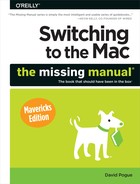What you see depends on whether you installed Mavericks onto an older OS X drive or an empty drive.
If you installed onto a drive that already had OS X stuff on it—accounts, files, settings, and so on—then after the Mac restarts, all you have to do is log in as usual.
You’re asked for your Apple (iCloud) name and password, or you can sign up for one now. You’re asked if you want to turn on Find My Mac (Find My Mac, Find My iPhone) and if you’d like to use the new iCloud Keychain feature (WiFi Connections).
Note
It’s possible, at this point, that Mavericks will display a message warning you that it found some incompatible software on your Mac during the installation. You’ll discover that this outdated software has been summarily tossed into a folder called Incompatible Software in your startup disk’s main window.
You may also be asked if it’s OK for certain programs to access your calendar, reminders, or contacts—non-Apple programs you already own. Other programs may require that the Assistive Devices feature of OS X be turned on; you’re directed to the appropriate pane of System Preferences, where you’re supposed to turn on the appropriate checkboxes. All of these are security steps, new in Mavericks.
Finally, a little notification bubble appears on the desktop, offering to show you a “What’s New in OS X Mavericks” Web page.
If you installed Mavericks onto an empty drive, then the Setup Assistant is a little more involved.
Once again, you’re in for a click-through-the-screens experience, this time with the aim of setting up your Mac’s various options. After answering the questions on each screen, click Continue. The number of information screens you encounter may vary, but here are some of the possibilities:
Welcome. Click the name of the country you’re in.
Select Your Keyboard. Different countries require different keyboard layouts. For example, if you choose the Canadian layout, pressing the ] key on a U.S. keyboard produces the ç symbol. Click Continue.
Select a Network Connection. This is your chance to introduce the Mac to any networks in the vicinity. Click the name of the WiFi hotspot you want to join, for example. If there’s no wireless hotspot at all—hey, it could happen—then click Different Network Setup to specify, say, a wired or cellular network hookup.
Transfer Information to This Mac. The Setup Assistant can suck all your old programs, files, folders, and settings from the old Mac to the new one—or even from an old Windows PC to your new Mac. Meet the Migration Assistant.
Your choices here are From another Mac (connect your old Mac to this one over a network, even a wireless one); From a Windows PC (ditto); From Time Machine or other disk (connect your new Mac to your backup drive); and Don’t Transfer now.
Tip
You can always perform this sluggish task later. Just open the Migration Assistant program, in your Applications→Utilities folder, when it’s a better time. See After Installing onto a Blank Drive for more on migrating from Windows.
If you choose one of the first options and then click Transfer, the data-copying process begins. It can take a wicked long time.
Enter Your Apple ID. Here you’re offered the chance to type in an Apple ID (an email address and password for all your Apple dealings), which is more essential in Mavericks than ever before. If you don’t have one, just click Continue; you can get one and fill it in later.
Registration Information. This is your chance to become a grain of sand on the great beach of the Apple database (and to set up your own “card” in OS X’s Contacts program).
Create Your Computer Account. Most of the steps up to this point have been pretty inconsequential, but this is a big moment. You’re about to create your account—your Administrator account, in fact, as described in Chapter 14.
All you have to do is make up a name, usually a short variation of your name, and a password. Choose carefully; you can’t easily change your account name later.
What you come up with here is extremely important, especially if several people use this Mac at different times, or if other people connect to it on a network.
If you’re the only one who uses your Mac, it’s perfectly OK to leave the password blank empty.
Select a Picture For This Account. If your Mac has a built-in camera (laptops and iMacs do), you can take a photo of yourself to use as your account icon. Just click “Take a video snapshot.” You get a 3-second countdown, and then the Mac snaps your photo. (You can always reshoot it.) Adjust the cropping by dragging inside the photo, and adjust the size by dragging the slider beneath it.
If you’re camera-shy, of course, you can choose “Choose from the picture library” and find an Apple-provided icon instead.
Thank You. When you click Start Using Mavericks, you wind up at the OS X desktop, just as described in Chapter 1.
